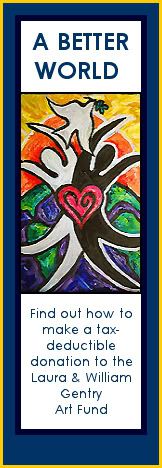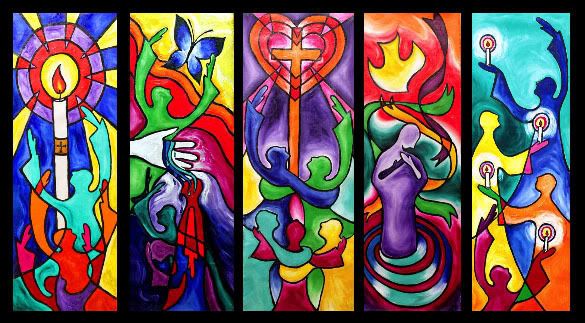A Sermon for Holy Trinity Sunday
June 3, 2007
by Pastor Laura Gentry
John 16:12-15
I still have many things to say to you, but you cannot bear them now. When the Spirit of truth comes, he will guide you into all the truth; for he will not speak on his own, but will speak whatever he hears, and he will declare to you the things that are to come. He will glorify me, because he will take what is mine and declare it to you. All that the Father has is mine. For this reason I said that he will take what is mine and declare it to you. (NRSV)
Grace and peace to you from God our Father, and from our Lord and Savior, Jesus Christ.
Today, we celebrate Trinity Sunday—the only day of the church year dedicated to a theological teaching of the church not associated with the life of Jesus and given the name “Trinity,” which is not even in the bible. To this, you probably respond, “HUH?” Why in the world is such a ancient and difficult-to-understand festival sandwiched right into our church year? How did it begin? And what purpose does it serve?
It all began in the ninth century where Christians in French monastic communities would celebrate the festival of the Holy Trinity. They were carrying on the tradition of the early Christians, who developed the teaching of the Trinity in order to give them a common understanding of God , which helped Christians understand that God was one, not three gods. Later, in the fourteenth century, the festival became so widespread that it was added to the church calendar and has been celebrated throughout the world ever since.
Saint Augustine, one of the most prominent Christian thinkers, often puzzled about the whole idea of describing God as a Trinity. He described an incident in which he was walking along the beach and observed a young boy with a bucket, running back and forth to pour water into a little hole. Augustine asked, "What are you doing?" The boy replied, "I'm trying to put the ocean into this hole." It suddenly occurred to Augustine that just as this boy was pursuing the ridiculous goal of putting the whole ocean into the hole, he was pursuing an equally ridiculous goal: trying to put an infinite God into his finite mind. We, with our very limited brains (in comparison to God’s wisdom), have come up with the doctrine of the Holy Trinity—the belief that God is expressed in three parts as Father, Son and Holy Spirit. But we must recognize, as Augustine did, that we could never fully understand God—we could never capture God’s entire essence with a doctrine.
Garrison Keillor once said of love, “We should not think that we have figured this out, because it is not a problem, it’s a mystery and always will be.” The same could be said of the doctrine of the Trinity. We don’t have to think of it as a problem to be solved, but rather a glorious mystery in which to relish.
How, exactly, God can be three-in-one, we cannot know, but we can know God in three various ways. Through the biblical accounts, we have come to know God as God the Father—the Creator of our entire universe. In this morning’s lessons, we heard from the Genesis story of creation in which God calls the universe into being by the power of God’s word. God the Father is the all-powerful, eternal, yet loving source of all life.
We also know God as Jesus, the only son of the Father—the Eternal God become flesh, Emmanuel, God-with-us, who came to earth to live a life of service and to die and rise again to redeem us from our sin. Jesus made it clear that to know him was to know the Father, for they are one. In the letter to the Colossians, Paul says that "Christ is the image of the invisible God." In Christ, God created everything; in union with Christ all things hold together; in Christ all things are reconciled to God, bringing peace on earth and in heaven (Col. 1: 15-20). Jesus Christ has reshaped our understanding of God.
And we know God as the Holy Spirit —the one who is with us in this very moment, inspiring us, illuminating the Scriptures, animating our faith and worship, interceding for us in our weakness "with sighs too deep for words," leading us, strengthening us, turning on the lights for us when our paths become unclear, blowing as powerfully as the wind.
Three forms, and yet one God. The Athanasian Creed (on page 54 of the LBW) states “And in this Trinity, no one is before or after, greater or less than the other; but all three persons are in themselves, coeternal and coequal; and so we must worship the trinity in unity and the one God in three persons.” These three, equal persons of God work together in community as one, unified God. Some theologians insist that what is most important about belief in a triune God is not that we see God in three ways, but that we understand God as dynamic community. Within the triune God there is a special energy which expresses the love of God experienced in Jesus Christ.1
What is unique about Trinitarian theology, is that it explains that there is an inner relational energy within God which spills over into the Christian life. John of Damascus, an eighth-century theologian, described this way of understanding God by saying that there is an exchange of energy between the persons of the Trinity by virtue of their eternal love. The unity of the Trinity is not static substance, but an open and loving community. He used the Greek word "perichoresis" to describe the relationship going on within God. This word comes from the same root as the word "choreography." It suggests that there is a movement, a dance within the internal life of God. 2 When we worship God as Father, Son and Holy Spirit, we celebrate the love which flows in God's mysterious dance of togetherness.
So if God is community and we are created it God’s image, what does that mean? It means that we are created to be in relationship, just as God is in relationship. The doctrine of the Trinity gives us a vision of a community of women and men in church and society who treat each other as equals and work together in shared responsibility of unity and love. You see, when we understand God in terms of the doctrine of the Trinity, we can see within the very person of God, a radical example of a community built on justice, relationship and care. It gives us a vision that the self and the other should be treated as of equal worth; that despite differences in power, things should be fair; that every person should be responded to and included and that no one should be left alone and hurt.
This reminds me of a true story of a priest who was sent to serve an inner city church. His passion was for young children and families, yet this parish was a small congregation—just a handful of elderly people. “How can I possibly have a fruitful ministry here?” He wondered. After a few months, he happened to be visiting the hospital and stopped in to a visit a mother with her newborn son. She talked to the priest of her experience of childbirth, and said sadly, “But the problem is that we had this baby all alone.” He asked her what she meant by that. She went on to explain that their parents lived across the country from them. The young mother said, “This is a little scary for us. We have no one to go to for advice about parenting. Most of the people in our neighborhood are also young couples like us. I wish this baby had some grandparents nearby.”
And suddenly a light came on in the priest’s head, “Grandparents!” he thought, “My church as grandparents! The whole congregation is made up of grandparents.” So he talked some people in the church into visiting the home of the couple. They had such a wonderful visit! The young couple had been desperate for someone to be excited about the birth of their child and the elderly visitors had been desperate to get some young people into their church community. It wasn’t long before the couple started coming to church where their baby was doted on by dozens of “grandparents.” The couple got excited and started telling their neighbors about the wonderful congregation of older people who made such great surrogate grandparents. Little by little, more of the young families began attending the parish and what happened was a fantastic synthesis of old and young people, which caused the church to be reborn. In relationship, loneliness and solitude gave way to loving new community.
You see, as people created in the image of the Triune God, our greatest human longing is to be in union. To be whole, we need each other. That’s how God is made and that’s how God made us.
So that is what we are celebrating today. In very clear terms, the profound mystery of the Trinity tell us who God is: the Creator, the Redeemer, and the Spirit who exist in perfect community with one another. And as people formed in God’s image, it tells us who we are, and why we crave community. May our hearts follow this natural impulse to search and out and find connections with God and with one another that we may be one as God is one.
May the peace of God, which passes all understanding, keep our hearts and minds in Christ Jesus our Lord. Amen.
© Laura E. Gentry 2007
Subscribe to:
Post Comments (Atom)








No comments:
Post a Comment